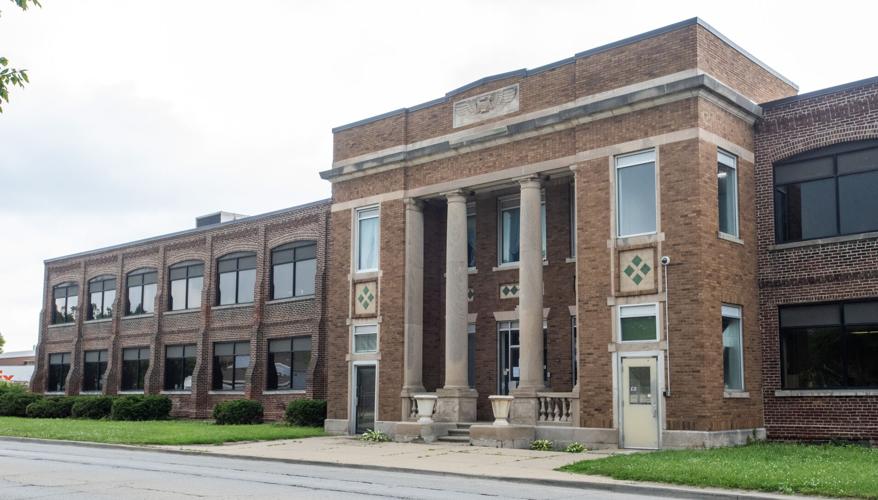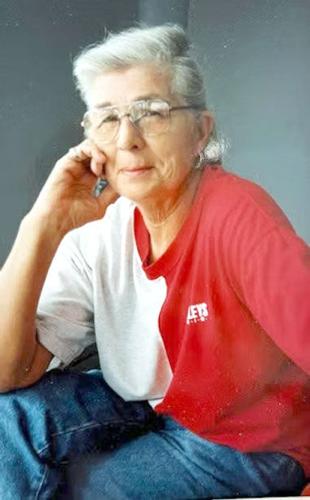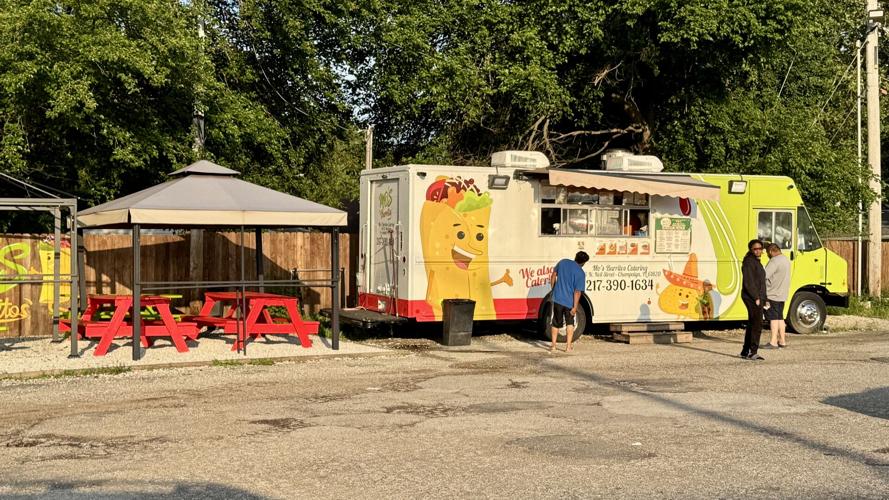Drop in a question of your very own BY CLICKING HERE or by emailing Kathy Reiser at mailbag@news-gazette.com.
As Herff Jones/Collegiate Cap & Gown starts winding down its Champaign operations, the Mailbag turns the tassel with a look back at the business’s history and some of the earlier occupants of the iconic building it’s called home for more than 85 years. Also: Why a new fire station in Champaign will be located near one of the city’s busiest intersections, what the House settlement will mean for the ICON for Illini collective, and some changes to this year’s Champaign County Freedom Celebration.

The Herff Jones/Collegiate Cap & Gown plant is shown Monday north of downtown Champaign.
NOW & THEN: Herff Jones/Collegiate Cap & Gown, 1000 N. Market St., Champaign
The Mailbag’s Now & Then feature has explored the history of more than 100 local commercial buildings over the past few years. And because “The Cap & Gown” has been part of our community … well, forever … I sort of assumed its original factory building was constructed specifically for that company.
Nope. It turns out a lot of local business history was made within those walls before Collegiate moved there in 1939.
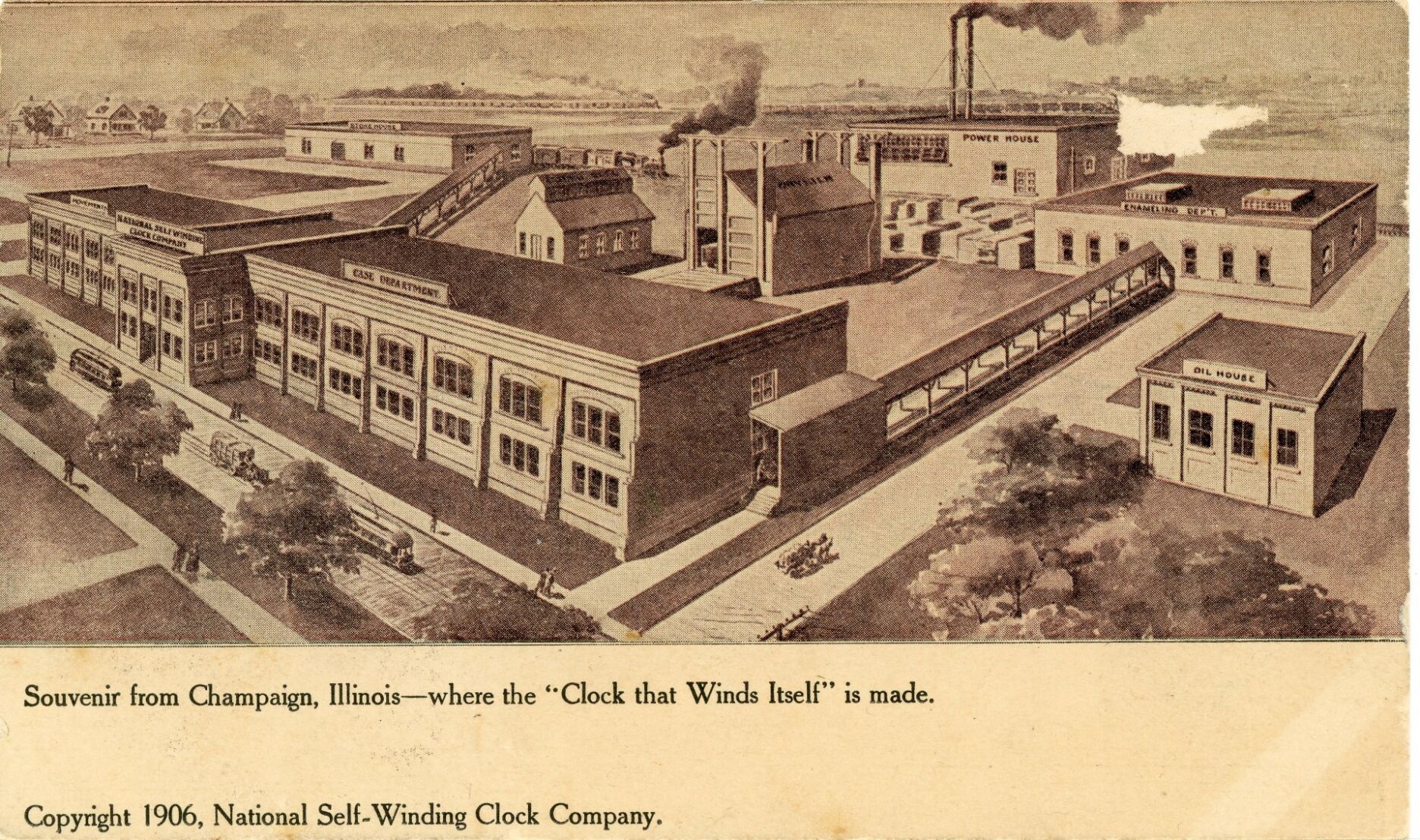
The building was originally constructed as a factory for the National Self-Winding Clock Company in 1905. It’s shown above in a souvenir postcard from 1906 — the same year the company went into foreclosure.
A Champaign Daily Gazette story from July 1905 reported that the National Self-Winding Clock Company soon would build a new manufacturing facility on “the old tile factory site.” The clockmaker had gotten its start in Chicago in 1895, made clocks in Elgin for a few years, then moved its operations to Bristol, Conn., in 1900.
“For several reasons, they never did well financially, and decided in the summer of 1905 to move back to Illinois,” wrote clock historian Ray Brown in a forum on the National Association of Watch and Clock Collectors website.
A March 1905 ad in the Gazette urged local residents to buy bonds to fund the company, which “will locate its entire plant, consisting of dies, tools, machinery and stock on hand, in Champaign. From 6 to 8 acres of land will be required for suitable grounds, lumber yards, etc. On this land will be erected substantial buildings for the manufacture of the movements and the clock cases. There will be employed, as quickly as possible, from 75 to 100 high-class mechanics. To carry out the plans of the company for manufacturing and placing clocks with the retail trade will require $100,000" — more than $3.2 million in today's dollars.
A little more than a year later, the Champaign County News reported that the company had taken out “one of the largest mortgages ever filed in this county,” in the amount of $500,000 — more than $16.5 million today.
Moving the clockworks to a newly built plant in Champaign did not improve its financial fortunes. Historian Jeffrey Kinkley pointed me to a 1924 article in Advertising and Selling Fortnightly magazine, which said the clockmaker ran into trouble after its elaborate, retailer-focused advertising campaign got way ahead of the factory’s production capabilities. Brown wrote that quality and production problems at the Champaign plant “resulted in catastrophic cash-flow problems, and the company went into foreclosure in the summer of 1906. The factory and contents were sold at auction in May 1908.”
The 1910 city directory shows the William A. Johnson Piano Company at the former clock factory, the address of which was 602 N. Market St. under Champaign’s old numbering system. Among Johnson Pianos’ offerings was an “A-roll coin piano” — a nickelodeon. In a 1978 article in the Automatic Musical Instrument Collectors’ Association newsletter, Art Reblitz called the local company “as obscure as any other small piano factory of the player-piano era.”
A 1913 map of Champaign-Urbana shows the former clock factory site as “J.W. Northrup Piano Co,” and the 1914 city directory lists the American Piano Player Co. at that address, with Johnson as president. By 1916, it seems the piano company was sharing space with the G.W. Cushman & Co. tool factory at the renumbered 1002 N. Market.

The 1919-20 city directory tell us the building was then the home of Caldwell Electric Corporation, manufacturers of electrical fixtures. The city of Champaign bought some of its earliest electric streetlamps for residential neighborhoods from Caldwell in about 1911, according to the November-December 1999 issue of the Preservation and Conservation Association newsletter. The contract was for $32,908, or a little over $1 million today.
By 1930, C.S. Johnson Co. and McArty Storage were listed at 1002 N. Market St. Nearly a decade earlier, in 1921, UI civil engineer Charles S. Johnson had founded a company that sold concrete-making machinery that revolutionized highway and dam building. The C.S. Johnson factory complex was located near Springfield Avenue and Kenwood Road. I found no clues about what the concrete manufacturer might have been doing, making or storing on Market Street.
McArty Storage and Twin City Beverage Co. (Roy B. Clemmons) were listed at 1002 N. Market in 1932, and McArty was still there in 1935. The 1938 directory shows Champaign Sheet Metal Works (ventilating & air conditioning contractors) was housed at that address, as was U.S. Club Car Trailer Co.

The latter made insulated travel trailers that could be towed by cars or light trucks. An ad for the company’s Custom 23 model says the trailer had three rooms … well, a couple of partitions, anyway … as well as fold-away beds, a shower and toilet, an “oven stove” and oil heaters.

A July 1939 News-Gazette article, shared by Perry Morris, announced that Collegiate Cap & Gown had signed an agreement to purchase the 7.5-acre factory site at 904-1002 N. Market Street and planned a “Collegiate Park” development there. The factory space was to be thoroughly modernized for efficiency, and the “spacious grounds lying north of the building will be landscaped and divided into 16 residential lots for the construction of homes for employees.” Architect George Ramey was drawing up plans for a modern office area to be located in the front wing on the first floor.
At some point after Collegiate bought the property, it changed its main address to the even 1000 N. Market St. now seen on the front of the building.
Collegiate was sold to Indianapolis-based Herff Jones in 1979. Herff Jones bills itself as the “everything graduation,” one-stop-shopping vendor of products ranging from class rings to graduation announcements, and caps and gowns to diplomas and diploma frames.
A short history of Collegiate Cap & Gown

Employees are shown at the sewing table at Collegiate Cap & Gown in 1936.
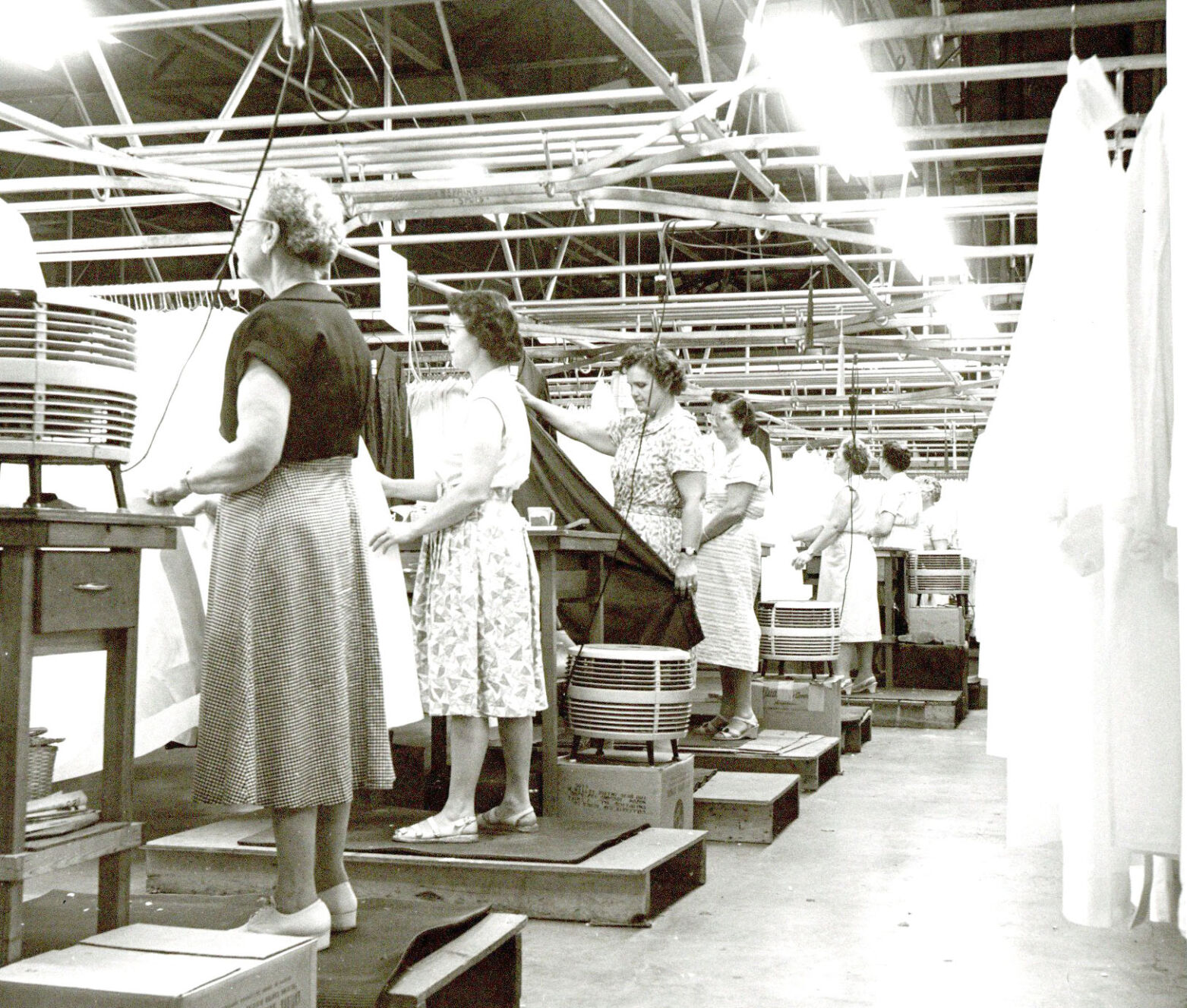
Rotary fans were a necessity on the floor of the Collegiate Cap & Gown factory in the early 1960s.

Employees box up caps and gowns during a 2014 Illinois Club tour of Herff Jones/Collegiate Cap & Gown in Champaign.
In researching the history of the main building at 1000 N. Market St. in its “B.C.” — before Collegiate — era, I ran across some fascinating history of the cap-and-gown business itself.
An undated (1936?) Illinois Magazine article in the files of the Champaign County Historical Archives says Harold “H.I.” Gelvin and associates started Collegiate Cap & Gown “as a rental agency for UI seniors.”
Gelvin was in the clothing business on campus even before the 1926 start of the cap-and-gown business with Fred G. Harrison and I.W. Davis. Historian Jeffrey Kinkley found a 1921 University High School yearbook ad for Gelvin’s Clothes Shop — “a college store for college men” — at 611 E. Green St.
The regalia-rental side of the business proved lucrative as Collegiate started renting caps and gowns to other colleges and a few high schools within a few years. In about 1929, the company started manufacturing its own graduation caps and gowns. Demand was growing as more high schools and junior colleges “began to demand ceremony at their graduations,” the magazine article said.
Gelvin explained that “a few years ago, only a few high schools were using them in Illinois. Now, at least 50 percent of them are. We supply 30 high schools to every college.”
Ironically, the Great Depression had a lot to do with the company’s growth in the 1930s.
“High school graduations have always been, in this democratic country, a cause for parents to deck their children in the best finery, and when money was more plentiful, this was not so bad,” the magazine article said. “But in the past few years, it’s been pretty tough on the bankroll to buy a graduation dress or suit. So, if caps and gowns are used, everyone looks the same, and there’s no sense of inferiority on anyone’s part … and it’s all in keeping with the democratic theory of the public school system.”
Back then, Collegiate used 75,000 yards of fabric per year in the manufacture of new gowns. The normal amount used for a gown was 7 yards, though there were exceptions.
“For instance, the Collegiate company made the cap and gown for Robert Wadlow of Alton for his graduation from high school last January," the article states. "Wadlow happens to be the tallest human in the world, the last reckoning of his height being 8 feet, 4 inches. (He is still growing.) It took 13¾ yards to make (his) gown.”

Making mortarboards at Collegiate Cap and Gown was described as ‘something of a carpentry job.’
In the company’s early days, mortarboard caps and tassels were mostly hand-made. It’s hard to imagine a more tedious job than making thousands of tassels by hand, strand by strand by strand.
“But Gelvin, believing there was a way for speeding it up, solved the question by inventing a machine — total cost 75 cents,” the magazine article said. “It involves threading the spools through a system of screw-eyes and attaching thread to a windlass, which is spun around ‘exactly 75 times.’ This was fine, but at first the spools would tangle with others of different color, so Gelvin merely placed them in old fruit cans to separate them.”

LEFT: An automated tassel-making machine installed in the 1930s at Collegiate Cap & Gown improved efficiency ‘by 1,000 percent,’ according to founder Harold ‘H.I.’ Gelvin. RIGHT: Collegiate’s perhaps most-famous employee, Sadorus native Dorothy ‘Dottie’ Schroeder, on the cover of Parade magazine during her playing days in the All-American Girls Professional Baseball League, and as local friends may remember her.
The new setup allowed for 30 tassels to be made at once, and “I would venture to say that our tassel-making efficiency has increased 1,000 percent,” Gelvin said.
A July 1939 article in The News-Gazette said Collegiate Cap & Gown began in the upstairs of 311 E. Green St. on the UI campus, then moved to the post office building at 704 S. Sixth St., and then to the four-story brick building at 102 S. Neil St. — today the home of Ratio Design. Collegiate bought the North Market Street building, of “fireproof brick and concrete construction,” in 1939 and set about modernizing it for maximum efficiency.
To keep the company’s workers busy throughout the year, Collegiate expanded its product line to include choir and pulpit robes, nurses’ capes, school uniforms and band members’ capes.
“Everything about the apparel, even the buttons, is made in the Champaign plant,” The News-Gazette article said.
Marybeth Eads, a long-time Collegiate employee, recalled in an online history discussion this week that the company also made all of the U.S. Supreme Court justices’ robes at one time.
“We designed the robe for Justice (Sandra Day) O’Connor," she said. "My friend Joyce Reeser Goode spearheaded that. A business named John Tudor’s College Shop handled the in-person measurements.”

Sadorus native Dottie Schroeder on the cover of Parade magazine during her playing days in the All-American Girls Professional Baseball League.

Sadorus native Dottie Schroeder (1928-1996), a longtime employee of Herff Jones/Collegiate Cap and Gown, as local friends may remember her.
Of course, we can’t run even a short history of Collegiate without mentioning the person who may have been its most famous employee — even if she wasn’t widely known until about the time she retired. The 1992 film “A League of Their Own” included a character loosely based on Sadorus native Dorothy “Dottie” Schroeder; Geena Davis played Schroeder in the film.
An accomplished shortstop who set numerous records, Schroeder was the only woman to have played in all 12 seasons of the All-American Girls Professional Baseball League, from 1943 until it disbanded in 1954. She went to work at the cap-and-gown factory in 1957 and was there for 36 years, until her 1993 retirement.
Later this summer, the Champaign County History Museum will feature an exhibit on Schroeder and her career in the AAGPBL.

The ICON for Illini collective and the House v. NCAA settlement
“In the wake of the House vs. NCAA settlement, what happens to ICON for Illini and similar collectives that raise and pool donor funds to compensate student-athletes for use of their name, image and likeness?"
That’s still being sorted out.
Kathleen Knight, president and CEO of ICON for Illini, said “we are pleased with the recent resolution of the House settlement. Despite that, many questions remain about the future of NIL and we are working collaboratively with the (UI) Division of Intercollegiate Athletics to determine how best ICON can continue to support Illinois student-athletes in this next phase.
“In the meantime, ICON will continue facilitating NIL opportunities for Fighting Illini student-athletes through local community service activities and engaging supporters through the ICON membership programs. ICON’s mission remains critical to the future success of Illinois athletic programs, and we are thankful to so many who have stepped up in support of Illini student-athletes through ICON’s endeavors.”
The settlement, reached in a case filed by lead plaintiff Grant House, a former Arizona State University swimmer, is a $2.8 billion agreement under which the NCAA and major conferences will implement a revenue-sharing model for student-athletes and pay former student-athletes for previously denied NIL earnings.

Changes to 2025 Champaign County Freedom Celebration
“Why was the Fourth of July parade moved to the afternoon and the Freedom 5K canceled this year?”
Diane Ducey, volunteer publicity chair for the Champaign County Freedom Celebration committee, asked University of Illinois police Capt. Joe McCullough about the parade changes, and he said both a new route and the new 4:30 p.m. start time “allows the parade to continue with fewer volunteers."
“The parade will be utilizing the UI Homecoming Parade route, which is very near the location of all the other activities — evening program, music, food trucks, sensory-friendly area with bubbles/foam cannon and, of course, the 9:15 p.m. fireworks with the patriotic soundtrack heard on 97.5 WHMS," McCullough said.
The Freedom Celebration’s website also notes that both the Youth Run and 5K Run/Walk are canceled this year. No specific reason is provided, but the website does note that volunteers are still needed for a variety of roles on July 3, 4 and 5.
Ducey said the parade units will line up at 3:30 between the UI’s Bielfeldt building (1700 S. Fourth St.) and State Farm Center. The parade starts at 4:30, going north on Fourth Street to Gregory Drive, west to First Street, south to Kirby Avenue, then east back to Fourth where it began.
“It makes sense for the parade to end where it began, so people walking next to the unit to toss out candy to the viewers from on foot can then join their friends and family, then head to Lot 31 (Stadium Terrace, across from Grange Grove) and enjoy the rest of the patriotic festivities,” she said.
Evening musical entertainment will begin as usual at 6 p.m. and the fireworks display will take place at dusk. The fireworks will be launched from Lot E-14, west of State Farm Center.
Ducey said further details on volunteering and making a donation, maps, “sponsors to patronize to show appreciation for their support of local events, all (are) found at July4th.net. We appreciate your readers evolving with these changes, especially with America's 250th in 2026.”

Damaged Columbia Place units
"Several units at Columbia Place, on the corner of Fifth and Columbia streets in Champaign, were damaged by fire a while back. Why hasn’t the city of Champaign or the Housing Authority demolished or repaired the units?”
The fire occurred on July 1, 2024, and affected eight of the 16 units at Columbia Place, which is owned by the Housing Authority of Champaign County. The two buildings provide housing for individuals age 55 and over.
Housing authority Executive Director Lily Walton says the agency “has been working closely with an architectural firm to bring the damaged portion of the building back up to code. We understand the impact this has on the surrounding community and are committed to seeing the property fully restored. We appreciate your concern and patience as we move forward with restoring Columbia Place.”
On Monday, she said her agency “will be posting a request for proposals for a general contractor later this week. The solicitation will remain open for approximately 30 days, after which a contractor will be selected following our procurement guidelines. We anticipate that repairs will begin later this summer.”
Meanwhile, units that were not affected by the fire remain habitable and are occupied. The damaged units have been secured to ensure the safety of residents and neighbors, Walton said.

Placement of Champaign's new Fire Station 3
“The Champaign City Council has approved construction of a new fire station at the southeast corner of Neil Street and Bradley Avenue. That’s a very busy corner, plus there’s a first-through-12th-grade school right across the street. Have they really thought this site through?”
Outgoing Champaign fire Chief Andy Quarnstrom says that’s a great question — and he believes the Neil-Bradley site is a good one for several reasons.
“First, this relocation will improve service levels to portions of the city and decrease response times to many of the calls in this station's service area," he said. "The new location will not decrease service for any part of the city by moving to this more centrally located location. It is not uncommon for fire stations to be located at or adjacent to intersections, as it allows for easier access to their respective response areas.”
As for the proximity to the Champaign school district's Columbia Center, he said fire stations near schools are not uncommon.
“Fire Station 2 (Bottenfield), Fire Station 4 (Centennial), Fire Station 5 (Garden Hills) and the current Fire Station 3 (Franklin) are all similar distances to schools," he said. "Our personnel take their driving responsibilities very seriously and work to protect the public — whether that’s students at the school, pedestrians or passing motorists, it’s a priority to operate as safely and efficiently as possible.”
Quarnstrom said the proposed new Fire Station 3 is planned for the south end of the large lot at Neil and Bradley, closer to Beardsley Avenue on the east side of Neil Street.
“This planned location … will alleviate some challenges with the actual Neil and Bradley intersection," he said. "Additionally, fire stations and fire trucks can not only control fire station access and egress, but they can also control intersections through various traffic-light pre-emption programming.”
All major intersections in Champaign have pre-emption systems, and Fire Station 2 and current Fire Station 3 have red lights at the station to stop traffic when trucks are heading out on calls. The new Fire Station 3 will have both of these tools, Quarnstrom said.
The plan is “to integrate street markings in front of the stations to remind drivers that fire truck traffic is to be expected,” he said, and work with nearby schools to keep students safe.
Malfunctioning siren?
“I have heard what appear to be false weather-warning sirens in Champaign multiple times within the past month during rainy weather. Each time, no warning was in effect. Is there a problem with the alert system?”
The person who submitted the question said the “whooo” sound lasts for a second or two, and seems to cut off “while the pitch is still ascending during the first oscillation.” The reader said they’d heard the short, siren-like sound in the vicinity of University Avenue and State Street, and near John and Prairie streets, in recent weeks.
John Dwyer, coordinator of the Champaign County Emergency Management Agency, told us on Tuesday that there had been no activations of the all-hazards sirens this month except for the monthly test on the first Tuesday (June 3).
“We get daily emails on the status of the sirens and when they are activated," he said. "I don’t know what they are hearing. It could be lightning detectors at golf courses and/or ball fields. They do sound similar, but they are not the same.”
Readers: If you’ve noted a similar “mystery siren” in your neighborhood with no severe weather in the area, it might not hurt to drop Dwyer a note about it at jdwyer@champaigncountyil.gov.
Details of this year's Half Century Club dinner
“When and where is this year’s Half Century Dinner? I want to be sure I don’t miss it!”
Now there’s a reader who likes to plan ahead. Nothing wrong with that!
The Half Century Club was formed in 1924 as an annual reunion to celebrate the history of Champaign County by those on the plus side of 50.
Club President Phyllis Williams tells us this year’s dinner is set for Oct. 23 at the Unitarian-Universalist Church Fellowship Hall in Urbana.
“The cost to cover expenses will be $35, again this year — fingers crossed," she said.
My Mailbag predecessor and local history buff Tom Kacich wrote about the group in 2020:
“As clubs go, it’s pretty hard to beat the Urbana Half Century Club. There is no initiation. There are no dues. There’s one meeting a year, and it’s a dinner meeting. A few people do all of the work. Members don’t have to sell bags of peanuts, rolls of candies or Christmas trees to raise money. The only real requirement is that you are on the plus side of 50, and sometimes they fudge that."
Plans for prime corner near downtown Champaign
“What is planned for that vacant lot at Neil Street and Springfield Avenue in Champaign?”
The lot has been empty since Concord Custom Cleaners was torn down in 2022. It’s certainly a prime piece of real estate, at one of the busiest intersections in town.
The city’s building-permits database shows that in May 2023, Green Street Realty applied for a building permit to construct a four-story, 24-unit apartment building on that corner. The permit application was voided in November 2023, with a notation that “this project is not going to move forward according to (architect) Josh Daly on 11.15.23.”
We reached out to Green Street Realty several days ago to ask if there are any new plans for the lot, and we have not heard back.
Champaign County’s property database shows Harper Rental Properties as the owner of the vacant lot at 401 S. Neil St., as well as the Champaign Do It Best Hardware building immediately to the west of it, and most of the other properties on that block — with all of the tax bills mailed to Green Street Realty.
The database shows a different owner/billing address for only one property on that block bounded by Neil, Springfield, Randolph and Healey streets: the commercial building fronting on Neil that houses Tasty Tart and Resistance Threads.

Food-truck seating and canopy
“I noticed the burrito food truck near Prospect and Bradley avenues has added what looks like permanent seating with a canopy. Is that new? I like it!”
The tables and canopies were added at Mo’s food truck about three years ago, says manager Brandon Anaya. But the colorful picnic tables do seem to “pop” a little more when the early evening sun hits them just right. While many food trucks occupy spaces on city streets, those that regularly set up shop on private property may have more flexibility to offer such amenities to their patrons.
“We plan on continuing this for as long as weather permits,” Anaya said.

